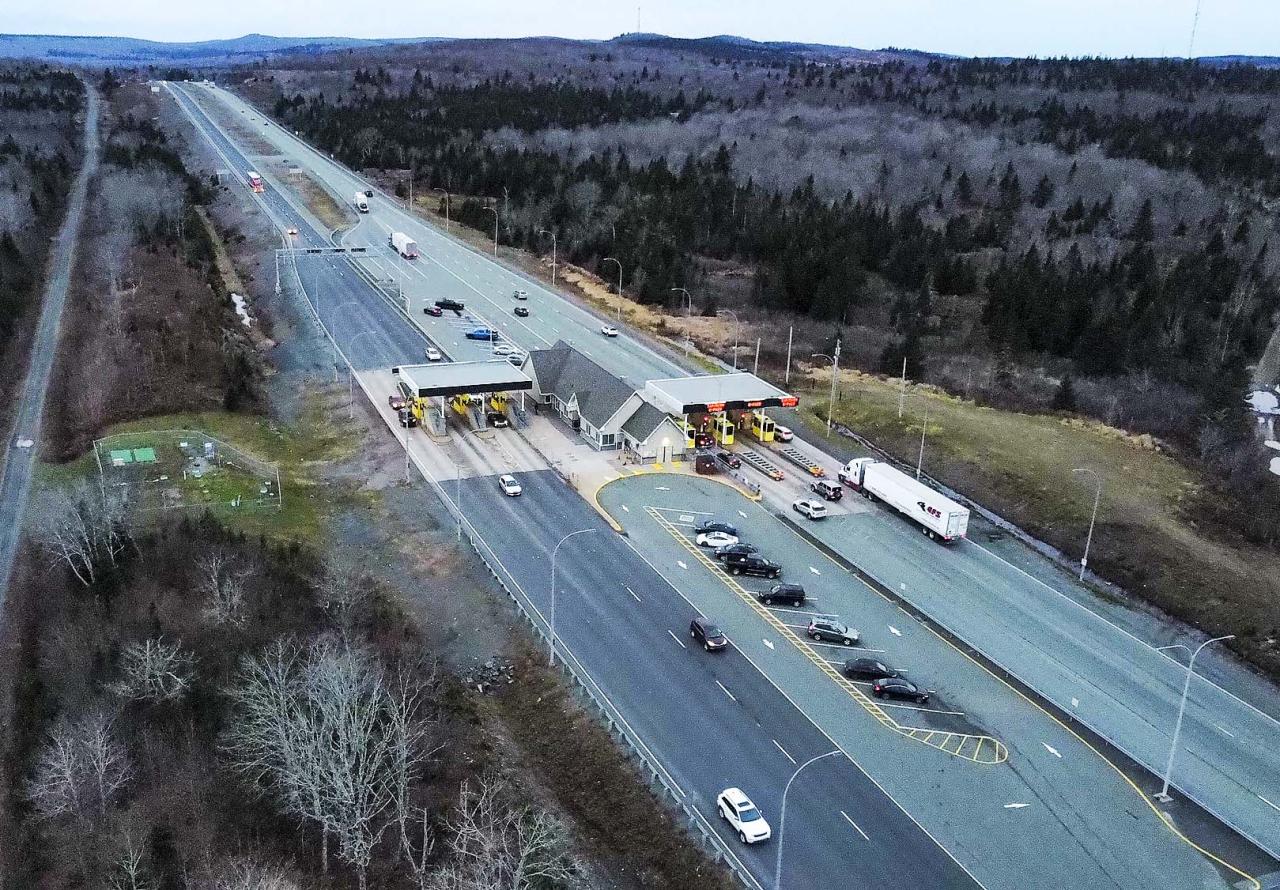Cobequid Pass camera systems play a crucial role in managing traffic flow and ensuring highway safety. These strategically placed cameras provide real-time views of traffic conditions, aiding in the swift response to incidents and contributing to a smoother driving experience for commuters. This exploration delves into the technical aspects, operational procedures, and overall impact of this vital infrastructure on the Cobequid Pass.
From analyzing peak and off-peak traffic patterns to assessing the effectiveness of the cameras in influencing driver behavior, this analysis provides a comprehensive overview of the Cobequid Pass camera network. We will examine the camera technology, image quality, accessibility of footage, and compare it to alternative traffic monitoring methods. Understanding this system is key to appreciating its role in enhancing safety and efficiency on this important thoroughfare.
Cobequid Pass Traffic Monitoring System

The Cobequid Pass, a vital transportation artery, benefits from a comprehensive traffic camera system designed to enhance safety and improve traffic flow. This system provides real-time monitoring capabilities, offering valuable data for drivers and transportation authorities alike. This article details the system’s functionality, coverage, image quality, accessibility, impact on driver behavior, technological aspects, alternative monitoring methods, and provides an illustrative example of a typical camera view.
Cobequid Pass Traffic Conditions
Traffic patterns on the Cobequid Pass vary significantly depending on the time of day and day of the week. Peak hours generally coincide with commuter traffic, resulting in higher traffic density and slower speeds. Off-peak hours experience considerably lighter traffic volume and faster speeds. Accidents, road construction, and adverse weather conditions frequently contribute to congestion. Weekday traffic is typically heavier than weekend traffic, with the most significant congestion occurring during weekday morning and evening commutes.
| Day of Week | Time of Day | Average Speed (km/h) | Traffic Density |
|---|---|---|---|
| Monday – Friday | 7:00 AM – 9:00 AM | 40-50 | Heavy |
| Monday – Friday | 5:00 PM – 7:00 PM | 40-50 | Heavy |
| Monday – Friday | 10:00 AM – 4:00 PM | 70-80 | Moderate |
| Saturday – Sunday | All Day | 60-70 | Light to Moderate |
Camera Locations and Coverage
The Cobequid Pass traffic camera system comprises several strategically positioned cameras offering comprehensive coverage along the route. Each camera’s location is carefully chosen to maximize visibility and monitor critical areas prone to congestion or accidents.
The Cobequid Pass camera provides a stunning view, often capturing wildlife and weather patterns. Recently, however, its footage sparked discussion about a completely unrelated event: a nearby drone show accident that raised concerns about safety regulations. The contrast between the serene landscape and the chaotic incident highlights the unpredictable nature of modern events, even in remote areas like Cobequid Pass.
The camera’s ongoing monitoring continues to document the region’s diverse happenings.
- Camera 1: Located near the Truro entrance, this camera provides a wide view of the approaching traffic. It has a viewing angle of approximately 120 degrees and a range of 500 meters. It is a fixed, high-resolution camera.
- Camera 2: Positioned midway through the pass, this pan-tilt-zoom (PTZ) camera allows for dynamic monitoring of a wider area and can zoom in on specific incidents. Its viewing angle is adjustable, and it has a range of approximately 1 kilometer.
- Camera 3: Situated near the exit at the other end of the pass, this fixed camera provides a view of the departing traffic. It has a similar viewing angle and range to Camera 1.
Camera Image Quality and Resolution
The cameras used in the Cobequid Pass system are designed to deliver high-quality images under various weather conditions. However, image clarity can be affected by factors such as heavy rain, snow, or fog. Night vision capabilities are present, though image quality is naturally reduced compared to daytime visibility. Potential improvements include the implementation of advanced image processing algorithms to enhance visibility in low-light conditions and the use of higher-resolution cameras.
Accessibility and Use of Camera Footage, Cobequid pass camera

Live feeds from the Cobequid Pass cameras are typically accessible to the public through the transportation authority’s website. Access to recorded footage may be more restricted and may require a formal request, potentially involving legal processes and adherence to privacy regulations. Official use often requires proper authorization and adherence to established protocols.
Impact of Cameras on Driver Behavior
The presence of traffic cameras is generally believed to encourage safer driving practices. Drivers are more likely to adhere to speed limits and maintain lane discipline when they know they are being monitored. A comprehensive study comparing accident rates before and after camera installation would provide more definitive evidence of their impact. A hypothetical study could involve analyzing accident data, driver speed data, and traffic flow data before and after camera implementation, comparing these metrics across different time periods and locations.
Technological Aspects of the Camera System
The Cobequid Pass camera system utilizes advanced technologies for image processing, data transmission, and storage. High-resolution cameras transmit data to a central server, where it is processed and stored. Regular maintenance and system updates are crucial for ensuring optimal performance. Potential upgrades could include implementing AI-powered analytics for traffic flow prediction and automated incident detection.
- Image Processing: Advanced algorithms for noise reduction and image enhancement.
- Data Transmission: High-bandwidth fiber optic cables for reliable data transfer.
- Data Storage: Redundant storage systems to prevent data loss.
Alternative Methods for Monitoring Traffic

While traffic cameras are effective, other methods exist for monitoring traffic flow. These include radar systems, loop detectors embedded in the roadway, and more recently, the use of GPS data from vehicles. Each method has its own advantages and disadvantages regarding cost, effectiveness, and data accuracy.
| Method | Cost | Benefits | Limitations |
|---|---|---|---|
| Traffic Cameras | High (initial investment, maintenance) | Visual data, wide area coverage | Weather-dependent, privacy concerns |
| Radar | Moderate | Speed detection, relatively low maintenance | Limited range, less detailed information |
| Loop Detectors | Low (installation), Moderate (maintenance) | Accurate traffic volume data | Limited coverage area, susceptible to damage |
Illustrative Example of Camera Footage

Imagine a scene captured on a clear afternoon. The camera, positioned near the midpoint of the pass, shows moderate traffic density. Vehicles are moving at a steady pace, mostly passenger cars and light trucks. The sky is mostly sunny, with some scattered clouds. Visibility is excellent.
There are no noteworthy events, such as accidents or stalled vehicles. The lighting is good, providing clear visibility of license plates and vehicle types. The overall scene depicts typical daytime traffic conditions on a non-peak day.
The Cobequid Pass camera provides a stunning, real-time view of the landscape, but imagine the possibilities of capturing even more breathtaking footage. For enhanced aerial perspectives, consider utilizing technology like sky elements drones , which offer high-resolution imagery and versatile flight capabilities. This would undoubtedly supplement the existing Cobequid Pass camera feed, offering viewers a more complete and dynamic visual experience.
The Cobequid Pass camera system stands as a testament to the evolving landscape of traffic management. By combining advanced technology with strategic placement, the system demonstrably improves safety, facilitates efficient traffic flow, and offers valuable data for ongoing improvements. Continuous monitoring, technological upgrades, and a mindful approach to data privacy will further optimize this critical infrastructure, ensuring its continued contribution to the safe and efficient use of the Cobequid Pass for years to come.
Common Queries: Cobequid Pass Camera
What happens if a camera malfunctions?
Maintenance crews are responsible for regular inspections and repairs. Malfunctions are addressed promptly to minimize disruption.
Is the camera footage stored permanently?
Monitoring traffic flow at Cobequid Pass often involves analyzing camera footage. The sheer scale and coordination required for such monitoring is reminiscent of the complex choreography needed for a large-scale drone show, like the spectacular florida drone show I recently saw featured online. The precision and technology involved in both are truly impressive, making me appreciate the sophisticated systems behind the seemingly simple act of observing traffic at Cobequid Pass.
Footage retention policies vary; typically, data is stored for a specific period for review and potential evidence, after which it is overwritten.
Who has access to the camera footage?
Access is typically restricted to authorized personnel, such as law enforcement and highway maintenance. Specific procedures are in place for requests from the public or other organizations.
How are privacy concerns addressed regarding the cameras?
The system is designed to balance safety and privacy. Guidelines and policies are implemented to ensure responsible data handling and adherence to privacy regulations.
